PUBH632: Analysis of Liquor and Gambling Legislation Act 2018 Essay
VerifiedAdded on 2022/10/02
|5
|1401
|20
Essay
AI Summary
This essay analyzes the Liquor and Gambling Legislation Amendment Act 2018, focusing on its role in regulating alcohol consumption and gambling in Australia. It explores the act's principles, context, and intent, highlighting its aim to amend the Liquor Control Reform Act of 1998 and the Gambling Regulation Act 2003. The essay examines how the law targets various population groups, including minors and adults, and addresses weaknesses in the public health law, such as compensation for harmed minors and the adequacy of fines. It also discusses the implications of the legislation in improving and protecting health and safety, emphasizing the need for stricter enforcement and higher penalties for significant players in the industry to ensure consumer protection and minimize harm. The essay concludes that while the act is beneficial, there is a need to address its loopholes for it to be more effective.
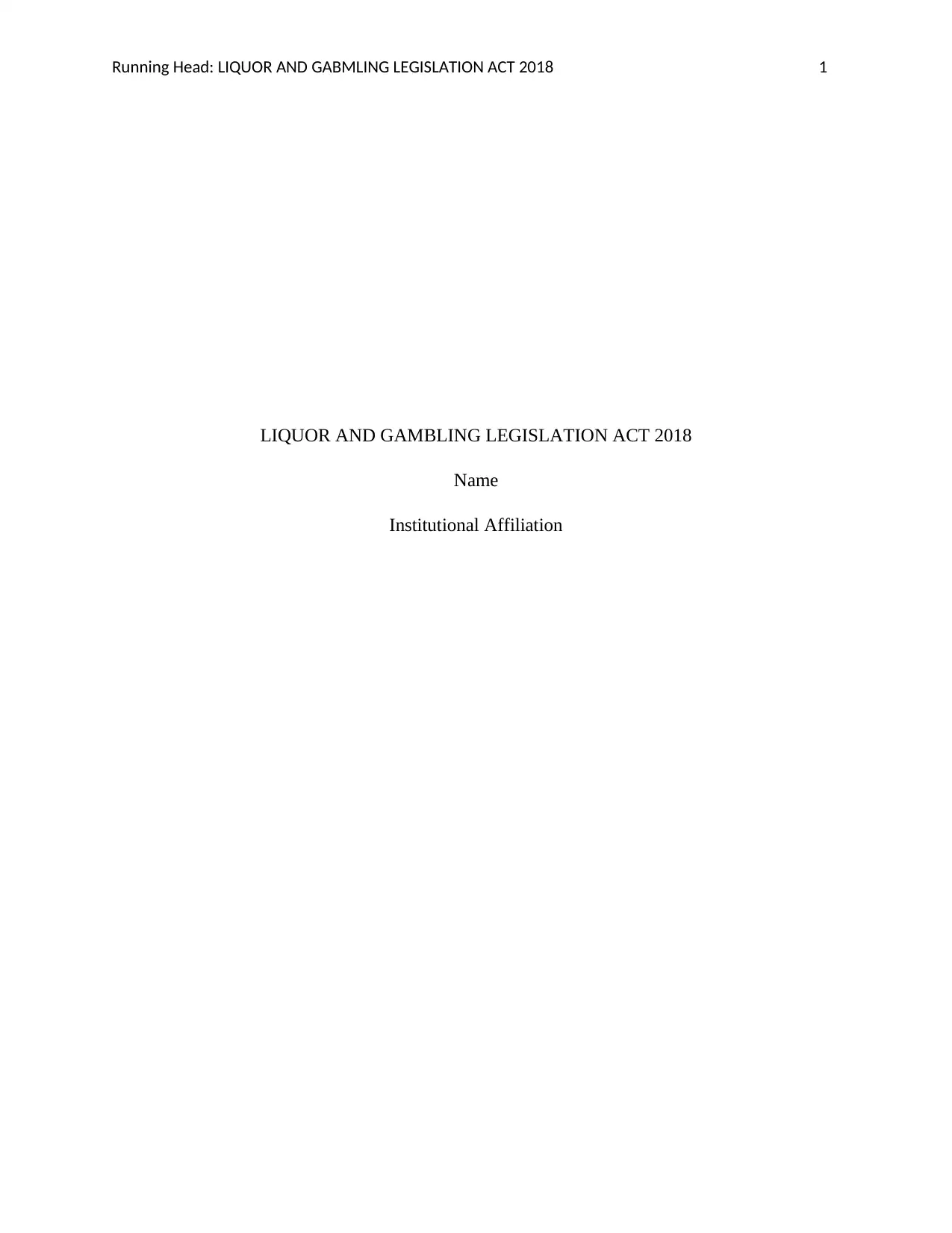
Running Head: LIQUOR AND GABMLING LEGISLATION ACT 2018 1
LIQUOR AND GAMBLING LEGISLATION ACT 2018
Name
Institutional Affiliation
LIQUOR AND GAMBLING LEGISLATION ACT 2018
Name
Institutional Affiliation
Paraphrase This Document
Need a fresh take? Get an instant paraphrase of this document with our AI Paraphraser
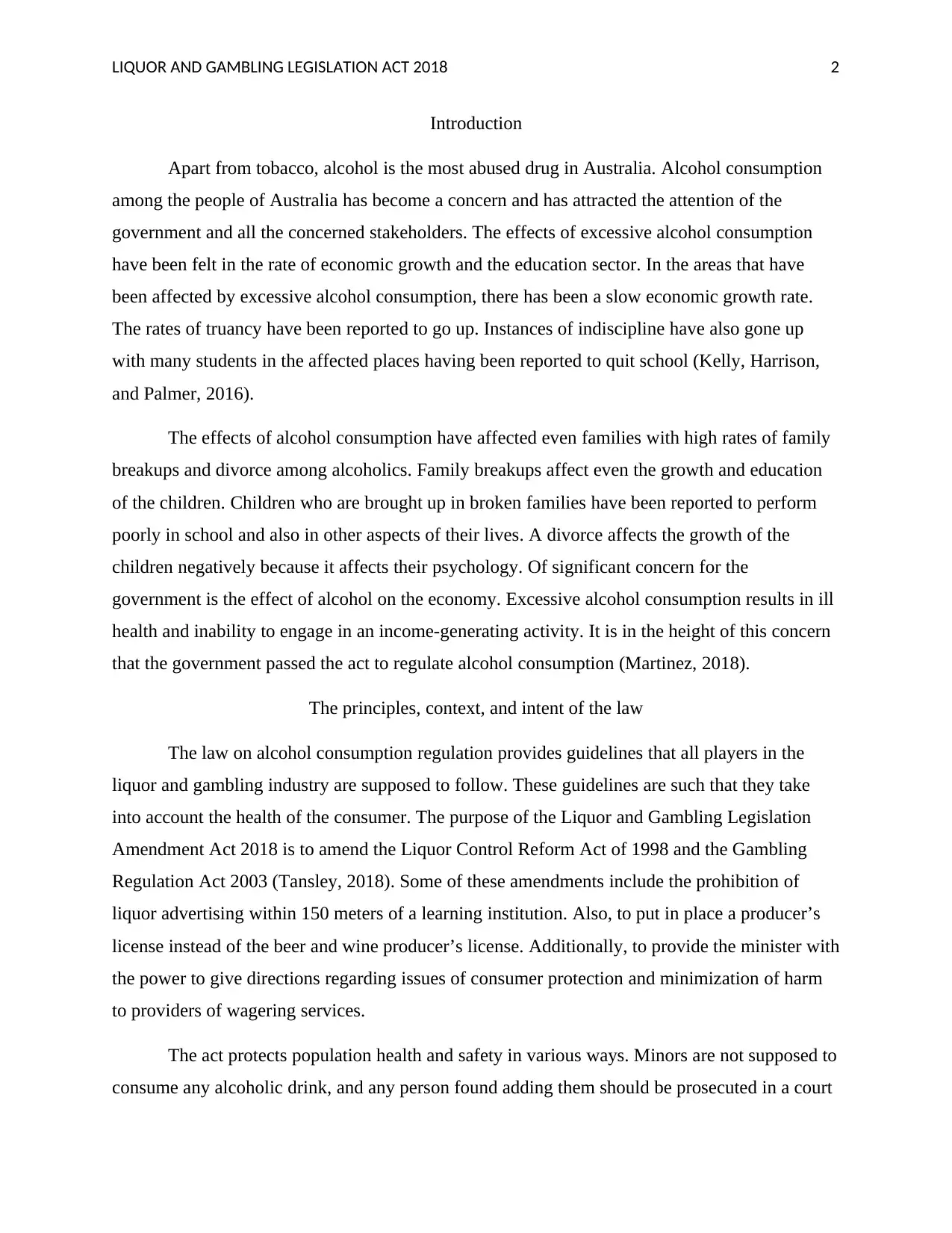
LIQUOR AND GAMBLING LEGISLATION ACT 2018 2
Introduction
Apart from tobacco, alcohol is the most abused drug in Australia. Alcohol consumption
among the people of Australia has become a concern and has attracted the attention of the
government and all the concerned stakeholders. The effects of excessive alcohol consumption
have been felt in the rate of economic growth and the education sector. In the areas that have
been affected by excessive alcohol consumption, there has been a slow economic growth rate.
The rates of truancy have been reported to go up. Instances of indiscipline have also gone up
with many students in the affected places having been reported to quit school (Kelly, Harrison,
and Palmer, 2016).
The effects of alcohol consumption have affected even families with high rates of family
breakups and divorce among alcoholics. Family breakups affect even the growth and education
of the children. Children who are brought up in broken families have been reported to perform
poorly in school and also in other aspects of their lives. A divorce affects the growth of the
children negatively because it affects their psychology. Of significant concern for the
government is the effect of alcohol on the economy. Excessive alcohol consumption results in ill
health and inability to engage in an income-generating activity. It is in the height of this concern
that the government passed the act to regulate alcohol consumption (Martinez, 2018).
The principles, context, and intent of the law
The law on alcohol consumption regulation provides guidelines that all players in the
liquor and gambling industry are supposed to follow. These guidelines are such that they take
into account the health of the consumer. The purpose of the Liquor and Gambling Legislation
Amendment Act 2018 is to amend the Liquor Control Reform Act of 1998 and the Gambling
Regulation Act 2003 (Tansley, 2018). Some of these amendments include the prohibition of
liquor advertising within 150 meters of a learning institution. Also, to put in place a producer’s
license instead of the beer and wine producer’s license. Additionally, to provide the minister with
the power to give directions regarding issues of consumer protection and minimization of harm
to providers of wagering services.
The act protects population health and safety in various ways. Minors are not supposed to
consume any alcoholic drink, and any person found adding them should be prosecuted in a court
Introduction
Apart from tobacco, alcohol is the most abused drug in Australia. Alcohol consumption
among the people of Australia has become a concern and has attracted the attention of the
government and all the concerned stakeholders. The effects of excessive alcohol consumption
have been felt in the rate of economic growth and the education sector. In the areas that have
been affected by excessive alcohol consumption, there has been a slow economic growth rate.
The rates of truancy have been reported to go up. Instances of indiscipline have also gone up
with many students in the affected places having been reported to quit school (Kelly, Harrison,
and Palmer, 2016).
The effects of alcohol consumption have affected even families with high rates of family
breakups and divorce among alcoholics. Family breakups affect even the growth and education
of the children. Children who are brought up in broken families have been reported to perform
poorly in school and also in other aspects of their lives. A divorce affects the growth of the
children negatively because it affects their psychology. Of significant concern for the
government is the effect of alcohol on the economy. Excessive alcohol consumption results in ill
health and inability to engage in an income-generating activity. It is in the height of this concern
that the government passed the act to regulate alcohol consumption (Martinez, 2018).
The principles, context, and intent of the law
The law on alcohol consumption regulation provides guidelines that all players in the
liquor and gambling industry are supposed to follow. These guidelines are such that they take
into account the health of the consumer. The purpose of the Liquor and Gambling Legislation
Amendment Act 2018 is to amend the Liquor Control Reform Act of 1998 and the Gambling
Regulation Act 2003 (Tansley, 2018). Some of these amendments include the prohibition of
liquor advertising within 150 meters of a learning institution. Also, to put in place a producer’s
license instead of the beer and wine producer’s license. Additionally, to provide the minister with
the power to give directions regarding issues of consumer protection and minimization of harm
to providers of wagering services.
The act protects population health and safety in various ways. Minors are not supposed to
consume any alcoholic drink, and any person found adding them should be prosecuted in a court
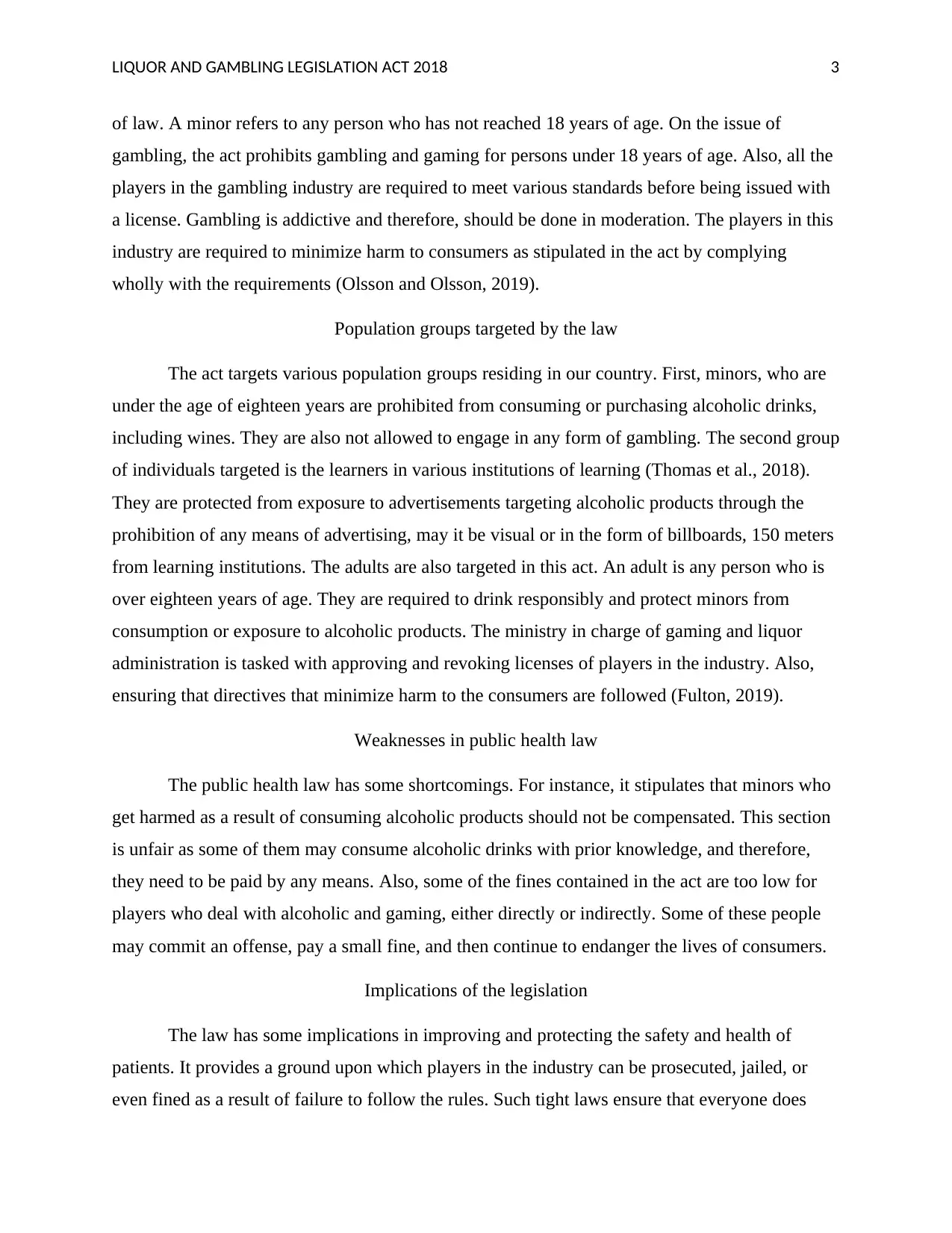
LIQUOR AND GAMBLING LEGISLATION ACT 2018 3
of law. A minor refers to any person who has not reached 18 years of age. On the issue of
gambling, the act prohibits gambling and gaming for persons under 18 years of age. Also, all the
players in the gambling industry are required to meet various standards before being issued with
a license. Gambling is addictive and therefore, should be done in moderation. The players in this
industry are required to minimize harm to consumers as stipulated in the act by complying
wholly with the requirements (Olsson and Olsson, 2019).
Population groups targeted by the law
The act targets various population groups residing in our country. First, minors, who are
under the age of eighteen years are prohibited from consuming or purchasing alcoholic drinks,
including wines. They are also not allowed to engage in any form of gambling. The second group
of individuals targeted is the learners in various institutions of learning (Thomas et al., 2018).
They are protected from exposure to advertisements targeting alcoholic products through the
prohibition of any means of advertising, may it be visual or in the form of billboards, 150 meters
from learning institutions. The adults are also targeted in this act. An adult is any person who is
over eighteen years of age. They are required to drink responsibly and protect minors from
consumption or exposure to alcoholic products. The ministry in charge of gaming and liquor
administration is tasked with approving and revoking licenses of players in the industry. Also,
ensuring that directives that minimize harm to the consumers are followed (Fulton, 2019).
Weaknesses in public health law
The public health law has some shortcomings. For instance, it stipulates that minors who
get harmed as a result of consuming alcoholic products should not be compensated. This section
is unfair as some of them may consume alcoholic drinks with prior knowledge, and therefore,
they need to be paid by any means. Also, some of the fines contained in the act are too low for
players who deal with alcoholic and gaming, either directly or indirectly. Some of these people
may commit an offense, pay a small fine, and then continue to endanger the lives of consumers.
Implications of the legislation
The law has some implications in improving and protecting the safety and health of
patients. It provides a ground upon which players in the industry can be prosecuted, jailed, or
even fined as a result of failure to follow the rules. Such tight laws ensure that everyone does
of law. A minor refers to any person who has not reached 18 years of age. On the issue of
gambling, the act prohibits gambling and gaming for persons under 18 years of age. Also, all the
players in the gambling industry are required to meet various standards before being issued with
a license. Gambling is addictive and therefore, should be done in moderation. The players in this
industry are required to minimize harm to consumers as stipulated in the act by complying
wholly with the requirements (Olsson and Olsson, 2019).
Population groups targeted by the law
The act targets various population groups residing in our country. First, minors, who are
under the age of eighteen years are prohibited from consuming or purchasing alcoholic drinks,
including wines. They are also not allowed to engage in any form of gambling. The second group
of individuals targeted is the learners in various institutions of learning (Thomas et al., 2018).
They are protected from exposure to advertisements targeting alcoholic products through the
prohibition of any means of advertising, may it be visual or in the form of billboards, 150 meters
from learning institutions. The adults are also targeted in this act. An adult is any person who is
over eighteen years of age. They are required to drink responsibly and protect minors from
consumption or exposure to alcoholic products. The ministry in charge of gaming and liquor
administration is tasked with approving and revoking licenses of players in the industry. Also,
ensuring that directives that minimize harm to the consumers are followed (Fulton, 2019).
Weaknesses in public health law
The public health law has some shortcomings. For instance, it stipulates that minors who
get harmed as a result of consuming alcoholic products should not be compensated. This section
is unfair as some of them may consume alcoholic drinks with prior knowledge, and therefore,
they need to be paid by any means. Also, some of the fines contained in the act are too low for
players who deal with alcoholic and gaming, either directly or indirectly. Some of these people
may commit an offense, pay a small fine, and then continue to endanger the lives of consumers.
Implications of the legislation
The law has some implications in improving and protecting the safety and health of
patients. It provides a ground upon which players in the industry can be prosecuted, jailed, or
even fined as a result of failure to follow the rules. Such tight laws ensure that everyone does
⊘ This is a preview!⊘
Do you want full access?
Subscribe today to unlock all pages.

Trusted by 1+ million students worldwide
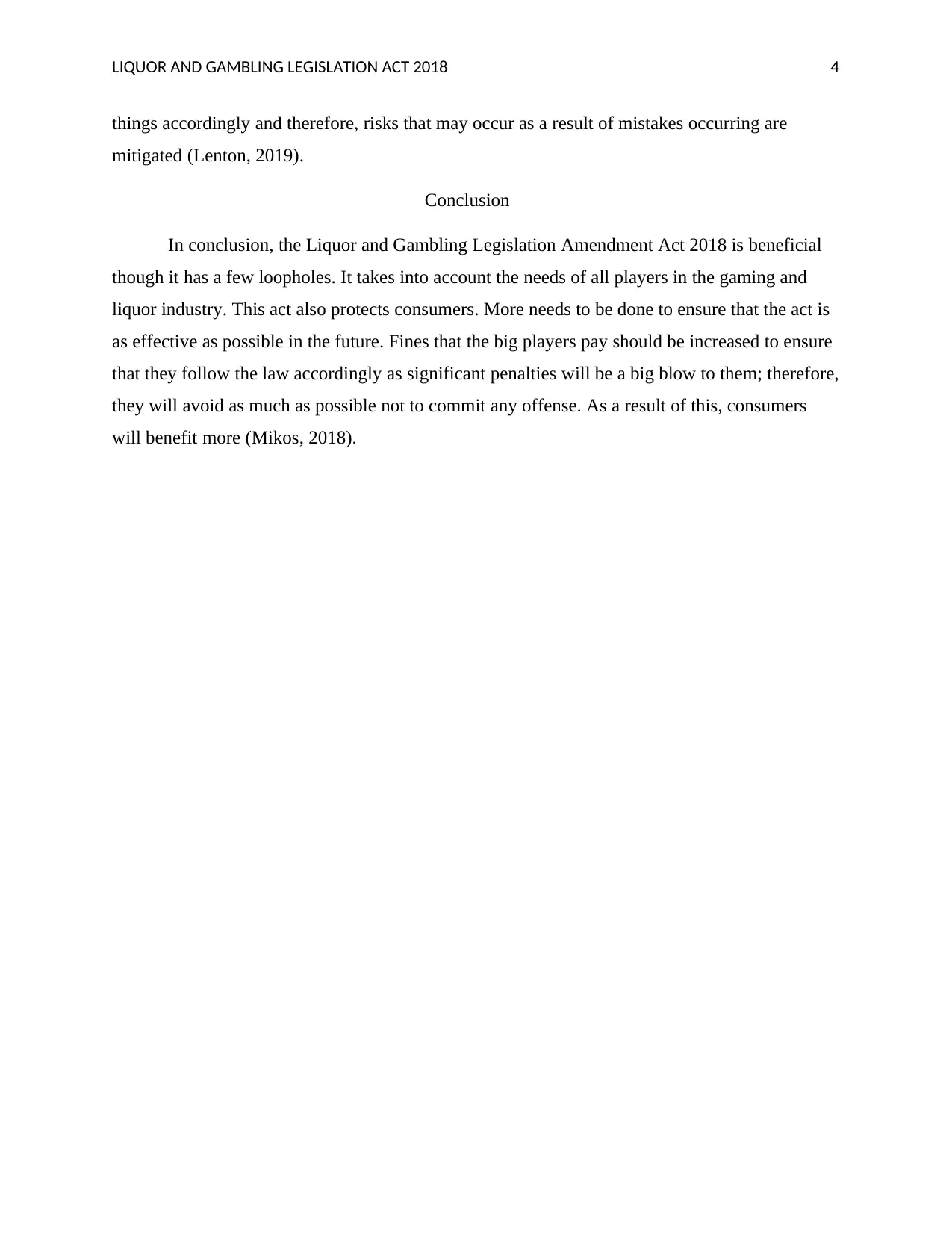
LIQUOR AND GAMBLING LEGISLATION ACT 2018 4
things accordingly and therefore, risks that may occur as a result of mistakes occurring are
mitigated (Lenton, 2019).
Conclusion
In conclusion, the Liquor and Gambling Legislation Amendment Act 2018 is beneficial
though it has a few loopholes. It takes into account the needs of all players in the gaming and
liquor industry. This act also protects consumers. More needs to be done to ensure that the act is
as effective as possible in the future. Fines that the big players pay should be increased to ensure
that they follow the law accordingly as significant penalties will be a big blow to them; therefore,
they will avoid as much as possible not to commit any offense. As a result of this, consumers
will benefit more (Mikos, 2018).
things accordingly and therefore, risks that may occur as a result of mistakes occurring are
mitigated (Lenton, 2019).
Conclusion
In conclusion, the Liquor and Gambling Legislation Amendment Act 2018 is beneficial
though it has a few loopholes. It takes into account the needs of all players in the gaming and
liquor industry. This act also protects consumers. More needs to be done to ensure that the act is
as effective as possible in the future. Fines that the big players pay should be increased to ensure
that they follow the law accordingly as significant penalties will be a big blow to them; therefore,
they will avoid as much as possible not to commit any offense. As a result of this, consumers
will benefit more (Mikos, 2018).
Paraphrase This Document
Need a fresh take? Get an instant paraphrase of this document with our AI Paraphraser
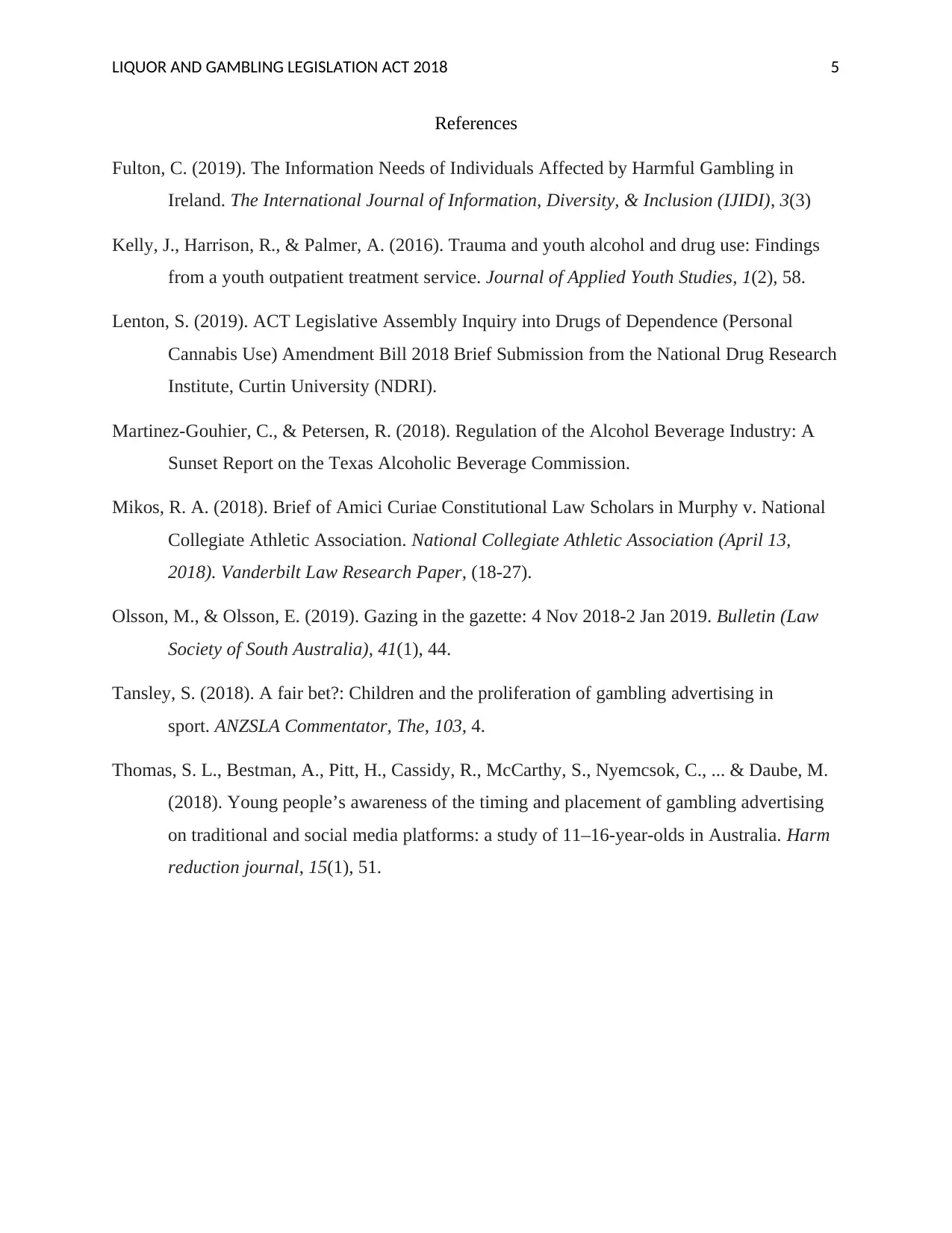
LIQUOR AND GAMBLING LEGISLATION ACT 2018 5
References
Fulton, C. (2019). The Information Needs of Individuals Affected by Harmful Gambling in
Ireland. The International Journal of Information, Diversity, & Inclusion (IJIDI), 3(3)
Kelly, J., Harrison, R., & Palmer, A. (2016). Trauma and youth alcohol and drug use: Findings
from a youth outpatient treatment service. Journal of Applied Youth Studies, 1(2), 58.
Lenton, S. (2019). ACT Legislative Assembly Inquiry into Drugs of Dependence (Personal
Cannabis Use) Amendment Bill 2018 Brief Submission from the National Drug Research
Institute, Curtin University (NDRI).
Martinez-Gouhier, C., & Petersen, R. (2018). Regulation of the Alcohol Beverage Industry: A
Sunset Report on the Texas Alcoholic Beverage Commission.
Mikos, R. A. (2018). Brief of Amici Curiae Constitutional Law Scholars in Murphy v. National
Collegiate Athletic Association. National Collegiate Athletic Association (April 13,
2018). Vanderbilt Law Research Paper, (18-27).
Olsson, M., & Olsson, E. (2019). Gazing in the gazette: 4 Nov 2018-2 Jan 2019. Bulletin (Law
Society of South Australia), 41(1), 44.
Tansley, S. (2018). A fair bet?: Children and the proliferation of gambling advertising in
sport. ANZSLA Commentator, The, 103, 4.
Thomas, S. L., Bestman, A., Pitt, H., Cassidy, R., McCarthy, S., Nyemcsok, C., ... & Daube, M.
(2018). Young people’s awareness of the timing and placement of gambling advertising
on traditional and social media platforms: a study of 11–16-year-olds in Australia. Harm
reduction journal, 15(1), 51.
References
Fulton, C. (2019). The Information Needs of Individuals Affected by Harmful Gambling in
Ireland. The International Journal of Information, Diversity, & Inclusion (IJIDI), 3(3)
Kelly, J., Harrison, R., & Palmer, A. (2016). Trauma and youth alcohol and drug use: Findings
from a youth outpatient treatment service. Journal of Applied Youth Studies, 1(2), 58.
Lenton, S. (2019). ACT Legislative Assembly Inquiry into Drugs of Dependence (Personal
Cannabis Use) Amendment Bill 2018 Brief Submission from the National Drug Research
Institute, Curtin University (NDRI).
Martinez-Gouhier, C., & Petersen, R. (2018). Regulation of the Alcohol Beverage Industry: A
Sunset Report on the Texas Alcoholic Beverage Commission.
Mikos, R. A. (2018). Brief of Amici Curiae Constitutional Law Scholars in Murphy v. National
Collegiate Athletic Association. National Collegiate Athletic Association (April 13,
2018). Vanderbilt Law Research Paper, (18-27).
Olsson, M., & Olsson, E. (2019). Gazing in the gazette: 4 Nov 2018-2 Jan 2019. Bulletin (Law
Society of South Australia), 41(1), 44.
Tansley, S. (2018). A fair bet?: Children and the proliferation of gambling advertising in
sport. ANZSLA Commentator, The, 103, 4.
Thomas, S. L., Bestman, A., Pitt, H., Cassidy, R., McCarthy, S., Nyemcsok, C., ... & Daube, M.
(2018). Young people’s awareness of the timing and placement of gambling advertising
on traditional and social media platforms: a study of 11–16-year-olds in Australia. Harm
reduction journal, 15(1), 51.
1 out of 5
Your All-in-One AI-Powered Toolkit for Academic Success.
+13062052269
info@desklib.com
Available 24*7 on WhatsApp / Email
![[object Object]](/_next/static/media/star-bottom.7253800d.svg)
Unlock your academic potential
Copyright © 2020–2025 A2Z Services. All Rights Reserved. Developed and managed by ZUCOL.
